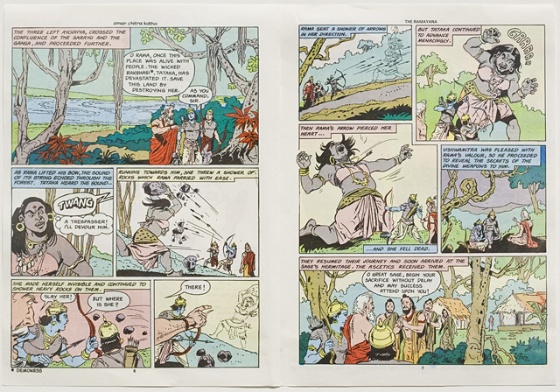Although colorism within Ramayana traditions was not a unit our class covered extensively, a few articles and some class discussions mentioned issues of colorism in the epic. Below, I will speak to colorism within the Ramayana as well as some of the social implications around colorism in India today. To do this, I will reference both the Ramayana comic and the Ramayana book. I am not interested in the determining if the Hindu epics like the Ramayana have influenced colorism in India over time, but rather, interested in the connection between colorism in both written text and stories as well as in social practice. Additionally, because there has been much more research of how colorism affects women in India, I make a point to address this. This does not mean, however, men do not experience colorism in India.
To look closely how both the Ramayana comic and the Ramayana translation have instances of colorism, first, colorism needs to be distinguished from racism. Both are discriminatory social constructions (Jones, 2000, 1493; Hunter, 2007, 237). Additionally skin color can be an indicator for race (Jones, 2000, 1497), however, colorism is about one’s “…actual skin tone, as opposed to racial or ethnic identity” (Hunter, 2007, 237). Instead of having different treatment based on another’s perceived race different from the discriminator (“racism”), colorism is based on prejudice against people with darker skin, usually within one’s ethnic or racial group (“colorism”; Parameswaran and Cardoza, 2009, 222).
Even though the term was coined in the United States (Jones, 2009, 1489), colorism is prevalent all over the world. Within India, there are a number of theories as to exactly where colorism began (Parameswaran & Cardoza, 2009, 32-33), but we can see it is integrated within a number of other social factors, like gender, class, caste, and more. Comics like the Amar Chitra Katha series can teach and influence children at an early age to value lighter skin along with other social hierarchies (Parameswaran & Cardoza, 2009, 21). Radhika Parameswaran and Kavitha Cardoza’s “Immortal Comics, Epidermal Politics: Representations of gender and colorism in India” (2009) studies extensively 30 books within the Amar Chitra Katha series and found that of the 960 pages, only 345 pages, or 36%, had dark-skinned characters, either human or animals (23). Within parts of the article, the Valmiki’s Ramayana comic is discussed. Within this comic, and the shorter Rama comic, Rakshasas are the only characters depicted with darker skin, and they are portrayed as aggressive, scary, and hideous (Parameswaran & Cardoza, 2009, 26; Pai, 1980). Lighter-skinned men are usually shown to be strong, healthy, clean, handsome, and often, noble (Parameswaran & Cardoza, 2009, 24-25; Pai, 1980).
Women in the Ramayana comic, and in the Amar Chitra Katha comic series in general, also have contrasting characteristics between those depicted with light skin and those with dark skin. Light-skinned females generally have high status like light-skinned males, are pure, loyal, and loving (Parameswaran & Cardoza, 2009, 29). Additionally, these women are beautiful, slim-figured, and young (Parameswaran & Cardoza, 2009, 29). In the Ramayana, Sita is a great example. Dark-skinned females in the comics are even more marginalized than their male counterparts, and when they do have roles, the low-status women are almost always depicted as monstrous, hypersexual, brutish, and evil (Parameswaran & Cardoza, 2009, 30). Shoorpanakha is one such example of a depiction of dark-skinned women (Parameswaran & Cardoza, 2009, 30-31; Pai, 1980). Another instance of dark-skinned women being violent and monstrous is in the image below. A page from the Ramayana comic (Pai, 1980) shows Tataka, a Rakshasi, violently throwing rocks at Rama and Lakshmana. As seen, she is drawn much darker than the other heroic characters (Pages from Valmiki’s Ramayana, Amar Chitra Katha, 1975). Coding of skin color and gender in the Ramayana comic promotes colorist ideas’ of light skin having ‘superiority’ over dark skin (Parameswaran & Cardoza, 2009).

Pages of Valmiki’s Ramayana from Amar Chitra Katha comic series, Los Angles County Museum of Art (LACMA)
Not only can colorism be seen in the children’s versions of the Ramayana, but it can be seen in more adult versions of the Ramayana as well. In the Ramayana, we can see a number of instances where again Rakshasas are usually depicted with dark skin and monstrous. One depiction of colorism and femininity shows the guard of Lanka as violent towards Hanuman who looks to enter the city disguised as a cat. “Suddenly, a dark-skinned women appeared from no-where before him, her face crooked in an unlovely smile, flames for her hair and a bleeding tigerskin for her dress, standing there in a halo of glowing lights and moving colors that looked like the burning clouds at the destruction of all three worlds” (Buck, 229). Here, destruction and chaos are invoked when describing a dark skinned woman. As seen before in the Ramayana comic, this woman is unfriendly, violent, and repulsive (Parameswaran and Cardoza, 2009; Buck, 1976; Pai, 1980) comic. Both the comic and the translated book of the Ramayana show colorism toward those with darker skin, particularly women.
Connecting the Ramayana to cultural values within India today, lighter skin is highly valued. The perceived superiority and value of lighter skin creates a market, especially for women (Parameswaran and Cardoza, 2009, 216-217). Skin color, particularly lighter skin tones, indicates beauty and higher status in many cultures, including India (Hunter, 2007, 246-247; Parameswaran and Cardoza, 2009, 226). Products like skin lighteners are used in many post-colonial countries like India and are used to whiten the skin (Hunter, 2007, 248). Below is an image of a popular skin lightener (L’Oreal, 2012) that describes white complexion as “perfect”. Even despite dangers of these lighteners like mercury poisoning, societal hierarchies create more benefits for those with light skin than dark skin, making women weigh whether lower status or physical risk is more detrimental (Hunter, 2007, 249; Jones, 2000, 1498).

L’Oréal skin whitening kit ad found on Teah Abdullah’s article “Skin Lightening, Racial Identity & Beauty Standards: Stop the Madness!”
A multitude of factors relating to the issues of colorism that have not been discussed are extremely important and pertinent to consider: gender (though this is mentioned above), class, caste, religion, and ethnicity are just but a few of these issues. Unfortunately, there is not a lot of research around colorism in India in general; most of the research on the topic of colorism speaks of African Americans in the United States (Parameswaran and Cardoza, 2009, 226). Hopefully, when colorism in India becomes better researched, masculinity and colorism will also be looked at. More research on colorism within epics, scriptures, and storytelling may produce more information about colorism within society (Indian or broader) as well, and in turn, the research on colorism within India may show new ways of reading and interpreting these religious texts.
Reference:
Abdullah, Teah. L’Oreal. Digital image. Feminspire.com. Feminspire Media Network, LLC, 12 Nov. 2012. Web. 20 Nov. 2014.
Buck, William. Ramayana. Berkley: University of California Press, 1976.
“Colorism“. Oxford Dictionaries. Oxford University Press, n.d. Web. 16 Nov. 2014.
Hunter, Margaret. “The Persistent Problem of Colorism: Skin Tone, Status, and Inequality.” Sociology Compass 1.1 (2007): 237-54. Web. 30 Oct. 2014.
Jones, Trina. “Shades of Brown: The Law of Skin Color.” Duke Law Journal 49.1487 (2000): 1487-557. Web. 28 Oct. 2014.
Pages From Valmiki’s Ramayana, Amar Chitra Katha, printed comic book, 1975, reprint 2007 (Los Angeles County Museum of Art (LACMA), Los Angeles, CA).
Pai, Anant. Vālmīki’s Ramayana. Bombay: India Book House, 1980. Print.
Parameswaran, Radhika E., & Kavitha Cardoza. “Immortal Comics, Epidermal Politics: Representations of gender and colorism in India.” Journal of Children and Media 3.1 (2009): 19-34. Web. 27 Oct. 2014.
—. “Melanin on the Margins: Advertising and the Cultural Politics of Fair/Light/White Beauty in India.” Journalism & Communication Monographs 11 (2009): 213-274.
“Racism“. Oxford Dictionaries. Oxford University Press, n.d. Web. 16 Nov. 2014.
